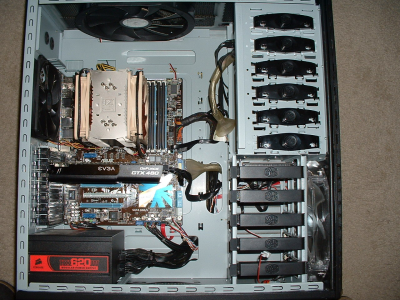- May 19, 2011
- 21,147
- 16,356
- 136
Well, I just went ahead and placed a large components order for my new PC (slight anxiety going on due to this being double what I've paid before for my own PC).
I've had plenty of experience installing stock Intel and AMD coolers, and I've gone a bit further up in the range to the upright tower coolers like Be Quiet! Pure Rock 2, but I'm wondering whether my usual technique for a larger and heavier cooler like this is still sound. I've checked board/case/ram/cpu compatibility on the Noctua website, it all checks out.
Normally when building a PC, I take the board out of its anti-static bag, put the board on the bag, then I put a couple of layers of old anti-static bags beneath plus a very thin layer of foam beneath that, then use the motherboard box to work on. At this point I install the CPU, RAM, HSF and M2 storage, then I lift the whole lot into the case. For stock coolers, installing into the case is rarely any kind of feat because they're small and unobtrusive, but the tower-type coolers can be a little trickier.
My normal thinking about HSF first then install the board in the case is that any pressure I put on the board while installing the HSF is cushioned/supported by the layers beneath, whereas if I installed the board in the case then the HSF, there's more potential for the board to flex when I apply pressure.
Maybe my concerns about room to work in the case are unwarranted since most of my PC builds have been into mATX cases especially in recent years and the case I intend to use this time is ATX and bigger than the usual ATX case I normally work in.
I've had plenty of experience installing stock Intel and AMD coolers, and I've gone a bit further up in the range to the upright tower coolers like Be Quiet! Pure Rock 2, but I'm wondering whether my usual technique for a larger and heavier cooler like this is still sound. I've checked board/case/ram/cpu compatibility on the Noctua website, it all checks out.
Normally when building a PC, I take the board out of its anti-static bag, put the board on the bag, then I put a couple of layers of old anti-static bags beneath plus a very thin layer of foam beneath that, then use the motherboard box to work on. At this point I install the CPU, RAM, HSF and M2 storage, then I lift the whole lot into the case. For stock coolers, installing into the case is rarely any kind of feat because they're small and unobtrusive, but the tower-type coolers can be a little trickier.
My normal thinking about HSF first then install the board in the case is that any pressure I put on the board while installing the HSF is cushioned/supported by the layers beneath, whereas if I installed the board in the case then the HSF, there's more potential for the board to flex when I apply pressure.
Maybe my concerns about room to work in the case are unwarranted since most of my PC builds have been into mATX cases especially in recent years and the case I intend to use this time is ATX and bigger than the usual ATX case I normally work in.




